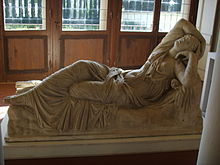User:Davidiad/epyllion
| This user page or section is in a state of significant expansion or restructuring. You are welcome to assist in its construction by editing it as well. If this user page has not been edited in several days, please remove this template. If you are the editor who added this template and you are actively editing, please be sure to replace this template with {{in use}} during the active editing session. Click on the link for template parameters to use.
This page was last edited by PrimeBOT (talk | contribs) 7 years ago. (Update timer) |

In classical studies the term epyllion (Ancient Greek: ἐπύλλιον, plural: ἐπύλλια, epyllia) refers to a comparatively short hexameter poem (or discrete episode within a longer work) that shows formal affinities with epic, but betrays a preoccupation with themes and poetic techniques that are not generally or, at least, primarily characteristic of epic proper.
Etymology and modern usage
[edit]Ancient Greek ἐπύλλιον (epyllion) is the diminuitive of ἔπος (epos) in that word's senses of "verse" or "epic poem"; Liddell and Scott's Greek–English Lexicon thus defines ἐπύλλιον as a "versicle, scrap of poetry" or "short epic poem", citing for the latter definition Athenaeus, Deipnosophistae 2.68 (65a–b):[1]
|
ὅτι τὸ εἰς Ὅμηρον ἀναφερόμενον ἐπύλλιον, ἐπιγραφόμενον δὲ Ἐπικιχλίδες, ἔτυχε ταύτης τῆς προσηγορίας διὰ τὸ τὸν Ὅμηρον ᾄδοντα αὐτὸ τοῖς παισὶ κίχλας δῶρον λαμβάνειν, ἱστορεῖ Μέναιχμος ἐν τῷ περὶ τεχνιτῶν. |
A short epic (epyllion) attributed to Homer, entitled The One for the Thrushes, acquired this name because Homer was rewarded with thrushes when he sang it to his children—Menaechmus tells the story in his On Artisans. |
This is in fact the only ancient usage of the word that shows anything approaching the connotations with which it is most often employed by modern scholars,[2] and epyllion did not enter the common language of criticism until the 19th century. Wolf was apparently responsible for popularizing the term, for two of his essays from early in that century are referred to by titles including epyllion: Ad Scutum Herculis epyllion Hesiodo subditum animadversiones (Observations on the Shield of Heracles, an Epyllion Falsely Attributed to Hesiod) and Theocriti idyllia et epyllia (The Idylls and Epyllia of Theocritus).[3] The locus classicus for the sense of epyllion as a hexametric mythological poem that is not only comparatively short, but also imbued to some extent with the characteristics of Hellenistic poetry is Moritz Haupt's 1855 study of Catullus 64,[4] but it is likely that Haupt was using a term that had in the preceding decades become common to discussions of the shorter narrative poems of the Alexandrians.[5]
In the early 20th century the first studies specifically devoted to the concept of the epyllion were undertaken, with Leumann's work on Hellenistic epyllia, Jackson's study of the possible Roman examples, and Crump's attempt at a diachronic study of the epyllion as a single genre whose history could be traced from the Greek poems of the Hellenistic period through the Augustan period's Latin texts.[6]
Richard Hunter's recent appraisal summarizes well the current opinion regarding epyllia:
"Even if the term 'epyllion' has no ancient authority, there has seemed to be a phenomenon which cannot be ignored. Modern discussion has, however, been bedevilled by the grouping together of poems so diverse as to render that grouping almost meaningless, however many points of individual contact they may share."[7]
Characteristics
[edit]Scale
[edit]Meter
[edit]Subject matter
[edit]Poetic techniques
[edit]Callimachus, Hecale fr. 1 Hollis = 230 Pf.:
| Ἀκταίη τις ἔναιεν Ἐρεχθέος ἔν ποτε γουνῷ. | A certain Attic woman once resided in Erechtheus' highlands |
Catullus 64.50–54:
| haec vestis priscis hominum variata figuris heroum mira virtutes indicat arte. namque fluentisono prospectans litore Diae, Thesea cedentem celeri cum classe tuetur indomitos in corde gerens Ariadna furores |
This cloth, embellished with the figures of earlier men, showed with remarkable art the virtues of the heroes. For gazing from the wave-resounding shore of Dia, she saw Theseus departing with his swift ship, Ariadna, nursing indomitable furor in her heart. |
History
[edit]Hellenistic
[edit]- Philitas, Hermes
- Alexander Aetolus, Fisherman
- Callimachus, Hecale
- Theocritus 13, 22, 24, [25]
- Eratosthenes, Hermes (debated)
- Moschus, Europa
Latin
[edit]- Cinna, Zmyrna
- Calvus, Io
- Catullus 64
- Vergil, Georgics 4.315–558: the Aristaeus-epyllion
- Vergil, Aeneid 9.182–234
- Ovid, Metamorphoses 8.611–724: Baucis and Philemon
Late antiquity
[edit]Use in other literartures
[edit]See also
[edit]Works cited
[edit]- Allen, W. (1940), "The Epyllion: A Chapter in the History of Literary Criticism", TAPA, 71: 1–26.
- Allen, W. (1958) "The Non-Existent Classical Epyllion", Studies in Philology 55 (1958) 515–518.
- Crump, M.M. (1931) The Epyllion from Theocritus to Ovid. Oxford.
- Fantuzzi, M. & Hunter, R. (2004) Tradition and Innovation in Hellenistic Poetry. Cambridge. ISBN 978-0521835114.
- Fordyce, C. J. (1961) Catullus: A Commentary. Oxford. ISBN 978-0198721475
- Haupt, M. (1876) Opuscula: volumen secundum. Leipzig. Reprinted in 1967 by Georg Olms Verlag (Hildesheim)
- Jackson, C.N. (1913) "The Latin Epyllion", Harvard Studies in Classical Philology 24 (1913) 37–50.
- Leumann, J. (1904) De epyllio Alexandino. Königsee.
- Liddell, H. G. et al. (1996) A Greek–English Lexicon, 9th ed. Oxford. ISBN 978-0198642268
- Most, G. W. (1982) "Neues zur Geschichte des Terminus 'Epyllion'", Philologus 126: 153–56.
- Reilly, J. F. (1953) "Origins of the Word 'Epyllion'", The Classical Journal 49: 111–14.
- Vessey, D. W. T. C. "Thoughts on the Epyllion", The Classical Journal 66 (1970) 38–43.
